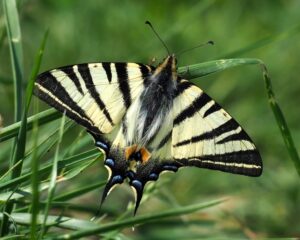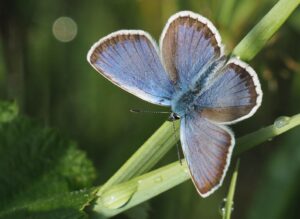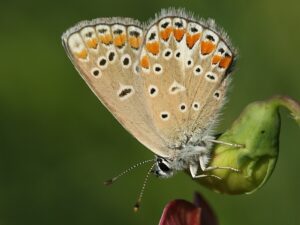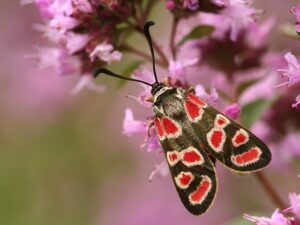Hipparchia semele (Linnaeus, 1758) – rock grayling
Family: Nymphalidae; Red list status (Hejda et al. 2017): critically endangered

A thermophilic species inhabiting rocky forest-steppes, sparsely overgrown sands, sparse forests and forest edges. It also uses artificial habitats like power plant sludge ponds, quarries, dumps with a suitable vegetation structure, i.e., a sufficient proportion of places with exposed substrate, sparse low vegetation with the presence of food plants (especially form genera Festuca) and solitary trees. In recent decades, Czech populations of this species declined markedly, and it went extinct in Moravia. In Prague, in the complex of protected areas of the Prokop and Radotín valleys, we can find one of the largest existing populations in Central Europe. Their further survival depends primarily on the active care of individual areas within protected areas as well as on the creation of new suitable habitats in their immediate neighbourhood. In 2020, several females were observed laying eggs in the newly created meadows at Dívčí hrady (C1, C2). As part of the project, we will increase the offer of suitable habitats for egg-laying in Dívčí hrady through appropriate management (creation of areas with disturbed grass turf), and we anticipate the gradual spread of the species to other localities.
Iphiclides podalirius (Linnaeus, 1758) – scarce swallowtail
Family: Papilionidae; Red list status (Hejda et al. 2017): nearly threatened

A thermophilic swallowtail species associated with rose bushes and trees, especially hawthorn (Crataegus) and plum (Prunus), on which the larvae develop. It occurs locally in overgrown thermophilic slopes, rocky steppes and forest-steppes, embankments, extensive orchards, and gardens. In some regions of Czech Republic, this species is declining. However, it is quite abundant in the area of Prague, mainly in areas around the Vltava and Berounka river valleys. This distribution is probably related to suitable sites for larval development, especially forest-steppes and extensive orchards. Due to its relatively high mobility, it can also be found in parks within the city centre, where it finds sources of nectar and occasionally also host trees. The project will seek to support its spread in sites neighbouring Prokop valley. Host plants (solitary roses, blackthorns, and hawthorns) will be maintained during pruning managements, and areas with nectar-rich herbs will be established.
Plebejus argus (Linnaeus, 1758) – silver-studded blue
Family: Lycaenidae; Red list status (Hejda et al. 2017): nearly threatened

A thermophilic species preferring dry grassland habitats, e.g., rocky steppes, dry meadows and pastures, including secondary habitats (post-mining areas or road embankments). Caterpillars develop mainly on legumes. Nowadays, it occurs in warm areas of the Czech Republic, but it has completely disappeared from some regions and its populations are experiencing a long-term decline. Several sites occur in the region of Prague, but many of them are located in areas with inappropriate management. To preserve viable populations within protected areas, it is necessary to consider appropriate management within sites in their immediate neighbourhood. During the butterfly monitoring at Dívčí hrady (C1, C2), we recorded several silver-studded blue individuals, proving evidence that this species is able to colonize newly created habitats. As part of the project, we want to further expand the potential of focal sites, e.g., to establish host plant patches also in other localities (A, B, D).
Polyommatus thersites (Cantener, 1834) – Chapman’s blue
Family: Lycaenidae; Red list status (Hejda et al. 2017): threatened

A thermophilic species occurring mainly in steppe sites. Caterpillars develop only on sainfoin plants (Onobrychis spp.). In the Czech Republic, its occurrence has always been linked to warm areas. Nowadays, it is reported mainly at the Ústí and Labem region and South Moravia. In the territory of Prague, Chapman’s blue occurred in many steppe localities, including the Prokop Valley. The last observation of the original populations in Prague comes from the Dalejský profile in 2004, so it can be considered regionally extinct. However, it was reintroduced in Prague in 2018 by our team. Unfortunately, during a detailed revision of most of its known populations in the České středohoří, it was not re-documented in many historical sites in 2020. Probably, its current state is more critical than the latest data provided during the creation of the Red List. The rapid decline of the species is likely to be due to a combination of several factors, such as inappropriate habitat management (overgrazing or overgrowing) and extreme weather conditions in recent years (high temperatures and drought during summer months that limited growth and flowering of sainfoin). In the proposed project, we will continue to take appropriate management of the newly created system of sainfoin patches in Dívčí hrady. Since the species has the potential to spread to other sites in the neighbourhood, we will continue to establish sainfoin patches in other sites managed within the proposed project.
Zygaena carniolica (Scopoli, 1763) – crepuscular burnet
Family: Zygaenidae; Red list status (Hejda et al. 2017): nearly threatened

A thermophilic burnet species inhabiting warm habitats with sparse short-stemmed vegetation. It prefers rocky and grassy steppes, forest edges, but also post-mining sites. Caterpillars develop on several legume species. Zygaena carniolica was abundant or common in warm areas of the Czech Republic in the past. Nowadays, however, this species has retreated from many regions. In Prague it occurs locally, especially within large protected areas. During surveys at the newly established sainfoin patches in Dívčí hrady, we observed their ongoing colonization from adjacent steppe grasslands of the Prokop Valley. As part of the project, we will continue to manage sainfoin patches in Dívčí hrady, as well as in other focal sites, and thus support a further spread of this species.